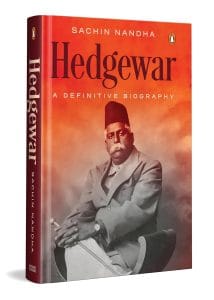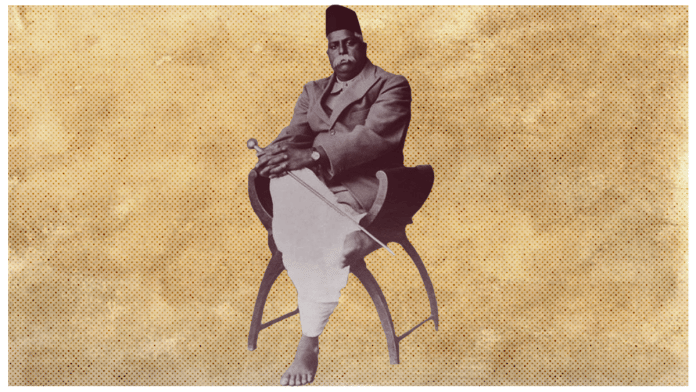Hedgewar tried remaining steadfast and emotionally steady as his body fell into a tailspin of poor health and sickness. Many of his closest friends tried to convince him to leave Nagpur and head out to a secluded natural reserve for rest and recuperation. After initially resisting their calls, he eventually agreed and headed out to the hot water springs at Rajgir in Bihar on 31 January 1940. Rajgir was one thousand two hundred kilometres away from Nagpur. It would take over twenty-four hours by train.
Rather unusually, Hedgewar asked his ardent stewards to accompany him. They were Appa Joshi, Babu Indurkar, Tatya Telang and Baba Kayani. Golwalkar, too, was expected but declined the offer due to impending work for the upcoming OTC due to be held in Pune later that year. The four men were insistent that they travel on the second-class carriage, where they were assured a place to sit and some peace. Hedgewar’s response was as expected, ‘No. The RSS does not have the funds,’ he said, ‘to offer us such luxury.’ Third class it was for all of them.
Passengers in the third-class carriages were poor, and the conditions were often basic. The seats were wooden, with no padding or cushions. Passengers had to sit on benches the entire time, often for hours on end and, in the case of Hedgewar, for days. The carriages were overcrowded, sweaty and smelly. The smell of human perspiration, the sign of hard labour coupled with little to no opportunity to bathe, and the pheromones of domesticated animals—often goats and chickens—would all fuse to create an insufferable environment.
Sitting next to the window or hanging out of the doorway was considered premium travel. Carriages were dirty and unsanitary, and there was always the risk of disease. There were no toilets in the third-class carriages, and passengers had to wait until the train stopped and use the facilities at the stations, which were also dirty and unhygienic. To travel in this way was never considered lightly; it was quite the ordeal.
Along the route, we know the train stopped at several towns and cities—where the entire carriage would empty, look for some space to do their bodily business and then return back in time to grab a seat near a window. For Hedgewar and his merry men every station meant visitors, swayamsevaks waiting patiently to see the man himself arrive. In the smaller towns, Hedgewar would often dish out whatever food they had brought along with them to the swayamsevaks at the station. This would have been a powerful gesture and one that people would have taken note of and respected deeply. They finally disembarked at Gaya, in Bihar, some two hours away from the hot water springs, to stay with Krishna-Vallabh Singh.
Even today, Gaya is not much of a town. However, just eight kilometres away lies a small village called Bodh Gaya, where the Buddha attained enlightenment. The tree under which he meditated still remains alive and is worshipped by millions of people each year. Hedgewar knew where he was and visited this hallowed place to take ‘darshan’, meaning to take light, knowledge or blessings from a source. For Hedgewar, this site was more than just a historically sacred place, it was rather a treasure trove of memory for millions of people; this, he felt, was a place from which his cultural nationalism ought to spring forth.
Also Read: Fasting has become a mark of privilege—all about self-obsession & excess
Cultural nationalism draws inspiration from shared culture, language and history to create a sense of national identity. For Hedgewar, this naturally meant promoting and celebrating important cultural sites and monuments, such as Bodh Gaya, that are emblematic of India’s history and identity.
Therefore, even today, the RSS proactively promotes and highlights any historical site or monument that is in any way rooted in the religions or cultural practices of India. The RSS today disowns the Taj Mahal—why? The answer is clear—it is the symbol of the ‘other’, the outsider, the tyrant and the oppressor—no inspiring cultural memories there. However, the temples of Ajanta or Ellora are quite different; these are sites that speak to the Indian mind and remind it of its deep past, indigenous religions and culture, a past before Islam and Christianity wreaked havoc on these lands. Hence, these are to be promoted.
Meanwhile, Nehru’s political nationalism, and likewise the modern-day Congress Party’s nationalism, is devoid of such historicity and narratives. For them, the emphasis is on capturing the state and its apparatus through which a union can be forged—one built on modernity, industrialization and some weird sense of secularism which, in India, is as dysfunctional as it can get. For Nehru, the Taj Mahal is important because it represents supreme state power, as does the Red Fort. But not for the RSS. This all goes back to Hedgewarian cultural nationalism. So, it is no surprise then that Hedgewar inaugurated several shakhas in Gaya and its surroundings.
On 6 February 1940, they made their way to the hot water springs in Krishna-Vallabh’s motor car. Hedgewar was simply unable to bear the pains caused by the uneven roads and travel by bullock cart, or an early version of a tuk-tuk, called a tum-tum. During the two-hour drive, which was in relative comfort, Palkar tells us that Hedgewar spoke at length about the psyche of someone rooted in cultural nationalism, or what he would have called ‘Rashtriyata’.6 He gave the analogy of birds and their relationship with an orchard. ‘The birds enjoy the orchard so long as it gives them fruit, juicy worms in the fertile soil and a place to build their nests.
If ever the orchard no longer suits their purpose, they will simply fly away and look for some other place. This, he said, ‘is not Rashtriyata.’’ As he spoke in raspy tones, his listeners could clearly make out the strain he was under. Rashtriyata, is when a person is completely fused with the idea of his or her nation, an unconditional oneness is achieved. The birds, when they realize that there is no ‘them’ without the garden, their very identity and well-being is interlocked with the garden; only then would the spirit of Rashtriyata arise.
The birds would realize that they are part and parcel of an eco-system and that the garden was as much theirs as they belonged to the garden. The Sangh, for Hedgewar, was the college that was constructed to build this spirit of devotion in the hearts of citizens, a spirit that notes there is no dignified self-identity without the dignity of the nation.It was the physical manifestation of ‘desh bhakti’, devotion to the very soil upon which one lived.
Hedgewar and his comrades were surrounded by history—Bodh Gaya to the South-east; the ruins of the Haryanka dynasty all across southern Rajgiri, a kingdom some two thousand five hundred years old; then to the mountain ranges where the Jain monk Mahavir lived and did penance to find enlightenment; to where the mythical kingdom of King Jarasandh was located on the hills overlooking the small town—a kingdom recorded in the epic Mahabharata, a story that is at least 5000 years old. Hedgewar was immersed in history, and it was the kind of history he was fighting for, the kind of history that was to fuel his brand of cultural nationalism.
In the West, we often fail to recognize that India has a living tradition that predates any other living culture in the world. Songs are still sung that would have been sung at the time of the Buddha, and mantras are recited at millions of homes that would have sounded the same around 1500 bce, and festivals are celebrated that belong to a primordial past. The RSS’s prachaarak order is still deeply rooted in this history and aims to ensure that India’s renewed freedom not only lasts but also rebuilds on this civilizational heritage.
Ram Jain, a local businessman, rented a four-bedroom house with a large lounge for meetings and a beautiful veranda looking out towards the lush green hills. The hot springs were about a kilometre away. Every morning at four-thirty, Joshi and Hedgewar would make their way to the springs by tum-tum while the others walked. The short, bumpy trip up the hill proved to be an exhausting experience for Hedgewar on some days. There was a small temple complex surrounding the hot springs. Situated at the foot of Vaibhava hill, he had to climb thirty-five steps to arrive at seven hot springs, all with holy significance for Buddhists, Jains and Hindus at large.
It wouldn’t be ludicrous to say that this place was for Hindus what Lourdes is to Christendom. Among the seven pools, Hedgewar was encouraged to bathe in Brahmakund, which, according to local folklore, was the most potent in healing. Brahmakund has a consistent temperature of 45 degrees. Today the spring is housed inside a temple complex, but in Hedgewar’s time it would have been directly under the morning sky. The air temperature would have been cool and moist. The water would have been hot and steamy. Hedgewar and Joshi would see the sun rise while bathing, concentrating on their breath, and feel the air warm with the first rays of the sun. It would have been quiet, with only a few people dedicated enough to trudge up the hill at that hour. Those that did make the effort were met with an orchestral delight—birdsong from the Indian silverbill and the magpie robin.
In these few moments, Hedgewar could afford to lose himself in the present, freeing him from a lifetime of self-imposed poverty and struggle. While Hedgewar continued to bathe under a small waterfall of hot spring water massaging his back, Joshi would make his way to the temple deity and begin a long series of mantras. It would be almost seven in the morning, well past sunrise, when the two men would leave their sanctuary.
 This excerpt from ‘Hedgewar: A Definitive Biography’ by Sachin Nandha has been published with permission from Penguin Random House India.
This excerpt from ‘Hedgewar: A Definitive Biography’ by Sachin Nandha has been published with permission from Penguin Random House India.






